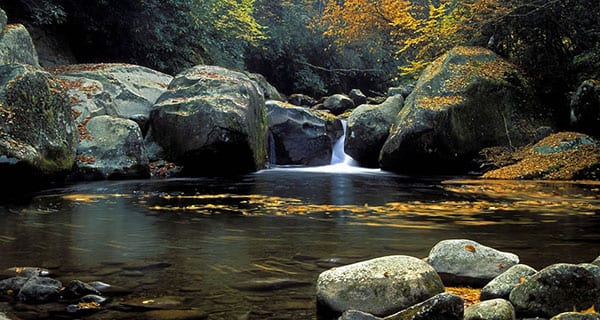
By James Marsh
Big Creek may not have as many aquatic insect hatches as some of the other streams in the park. This is probably because of its steep decline. When heavy rains occur in this part of the national park, flooding often occurs and the streambed is almost cleaned of everything that gets in the way. Most insects are either stoneflies or clinger mayflies. There are not many crawlers, swimmers and probably no burrowing mayflies. There are few caddisflies. The trout feed opportunistically most of the time.
The rainbows probably only average about seven inches long but they are fast, aggressive and fairly easy to catch if you stay hidden from them.
As mentioned in the introduction, this stream is big time pocket water. The huge boulders make some big pockets and holes. While dry fly fishing can be good at certain times, all in all this stream fishes much better with nymphs. Most of the aquatic insects are stoneflies. There are some clinger mayflies but they usually stay well hidden until they hatch. We suggest you use a stonefly nymph and especially during the times prior to a hatch of a particular species.
The “high stickin’” method of fishing a nymph works great in this stream. There are many boulders that allow you to get close to holes and pockets without spooking the fish. Some of the runs are deep and fast and it also works great there.
The headwaters provide some excellent brook trout fishing. The streams there are typical small, brook trout streams but they are usually very steep. You must climb up the streambed in most cases and that can be tough going in some areas due to the boulders and steep decline of the stream.
There are many tributary streams. Swallow Fork, Gunter Creek, Mouse Creek, McGinty Creek, John Mack Creek, Yellow Creek and Deer Creek are the larger ones. Of course, all of them are actually small. Swallow Fork is one of the larger ones. It has its own trial, which starts about five miles above the campground.
Brook trout exist quite low. In fact they can be caught within two or three miles upstream from Big Creek Campground at times. Most of them are much further than that. Most all of the main tributaries have brook trout. These small streams will produce nice brook trout during the hottest days of summer.
There is a large trail that follows the main stream up from the campground at the lower entrance to the park. It is located high above the stream in most cases. Getting down from it to the stream can be rough in many areas. Anglers have managed to make their own trail along the opposite side of Big Creek. The trail goes right beside the campground area next to the creek. If you are planning on hiking into the headwaters, then you would probably want to take the formal trail. There are several remote campsites on Big Creek.
James Marsh is the Owner of The Perfect Fly online and catalog mail-order store. www.perfectflystore.com.